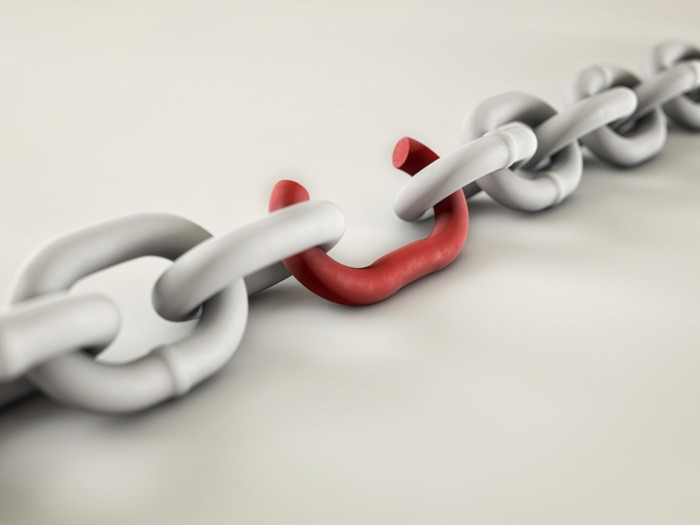Supply Chain Risks
Breaking the Chain

The increasing interconnectivity between businesses and their customers and suppliers has resulted in a large rise in business interruption (BI) and supply chain claims, according to industry experts.
Combined with a greater frequency and severity of natural disasters and extreme weather globally, as well as growing geo-political instability and unrest, this has left companies more exposed than ever before.
The Allianz Risk Barometer 2015 survey released in January revealed that BI and supply chain risk is the No. 1 peril for the third year running, with 46 percent of respondents rating it one of the three highest risks for firms.
“But because no single party owns the whole supply chain process it makes it hard to establish where the risk lies and how to measure it, particularly in areas such as cyber where there are multiple layers of ownership.” — Gary Lynch, founder and CEO, The Risk Project
The study found that the average BI claim at $1.36 million is 32 percent higher than the average property damage claim at $1.03 million, with the subsequent disruption amounting to more than the initial physical damage.
Gary Lynch, founder and CEO of The Risk Project, a supply chain risk management specialist, said that complex supply chains shared by multiple parties with different business models “inherently” had a large degree of risk attached to them.
“One of the biggest challenges from a risk manager’s perspective is that not only do they have to understand a company’s operating model, but also the broader economic model and the models of their business partners,” he said.
“But because no single party owns the whole supply chain process it makes it hard to establish where the risk lies and how to measure it, particularly in areas such as cyber where there are multiple layers of ownership.
“There’s no doubt that this increased interconnectivity is resulting in greater claims.”
Outsourcing Increases Complexity
Brian Kirwan, head of market management at Allianz Global Corporate & Specialty (AGCS) Regional Unit London, said that supply chain risk had been exacerbated by the global trend toward outsourcing over the last few years, adding to its complexity.
“What we are seeing is that continued globalization is creating complexity in the supply chain, which is the biggest challenge for risk managers.” — Brian Kirwan, head of market management, Allianz Global Corporate & Specialty Regional Unit London
“What we are seeing is that continued globalization is creating complexity in the supply chain, which is the biggest challenge for risk managers,” he said.
In addition, he said that BI losses as a proportion of an overall claim were also on the increase, which, in turn, was having a significant impact on company revenue.
“The first key component to get to grips with this is understanding the critical pieces of the supply chain, including the suppliers, and what impacts them — not only the credit risks, but also the catastrophe and insurance risks, as well as the concentration of risks,” he said.
Paul Carter, global head of risk consulting at AGCS SE, added: “Businesses spend a lot of time assessing direct damage and looking at their own BI impact but more work needs to be done analyzing the risks associated with suppliers and customers.”
Perry Rotella, group executive of Verisk’s supply chain risk analytics business, said that the main problem is while companies may have visibility of their direct suppliers, often they don’t have the necessary oversight of how the supply chain fits together and the geographical areas their production sites are located, as with the Thai floods in 2011.
“This increase in complexity combined with a growing number of natural disasters, extreme weather and geo-political instability has increased the risk for companies,” he said.
He added that, further down the line, the slightest supply chain disruption can have a knock-on effect, causing a company’s share price to drop, on average, by 7 percent, and often taking months to recover its value.
Chris Fischer Hirs, CEO of AGCS SE, added: “The growing interdependency of many industries and processes means businesses are now exposed to an increasing number of disruptive scenarios.”
The company’s survey of more than 500 risk managers across 47 countries found that the causes of BI that companies feared most were fire/explosion (43 percent) and natural catastrophes (41 percent).
Second only to BI and supply chain risks were natural catastrophes (30 percent) and fire/explosion (27 percent), according to the report.
Cyber (17 percent) and political risks (11 percent) were the biggest movers. Cyber crime/IT failures moved into the top five business risk ranking for the first time and are now among the top three risks in the U.S.
Meanwhile, loss of reputation (61 percent) and BI (49 percent) were cited as the main causes of economic loss following an incident.
But despite the increased awareness of cyber risks, many companies still underestimated the different impacts of it on their business, according to 73 percent of respondents.
Political/social upheaval was also a much bigger concern for businesses, climbing nine places to ninth. It’s also the second biggest cause of supply chain disruption (53 percent) after natural catastrophes, said the report.
By sector, the survey found that natural catastrophes remain the main risk for the engineering and construction industry, while BI is the biggest threat for manufacturers, and legislative and regulatory changes are top of the agenda in financial services.
Long-term, climate change and natural catastrophes, as well as so-called “disruptive technologies” such as 3D-printing and nanotechnology remain the biggest threats to companies, the report concluded.












